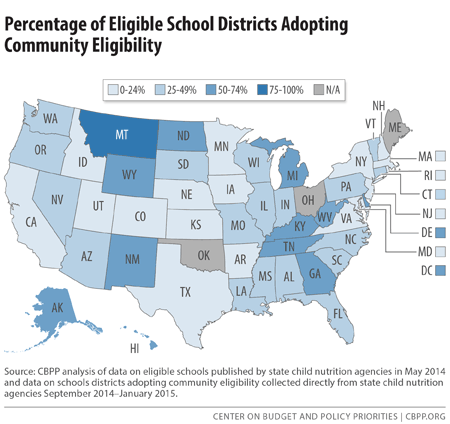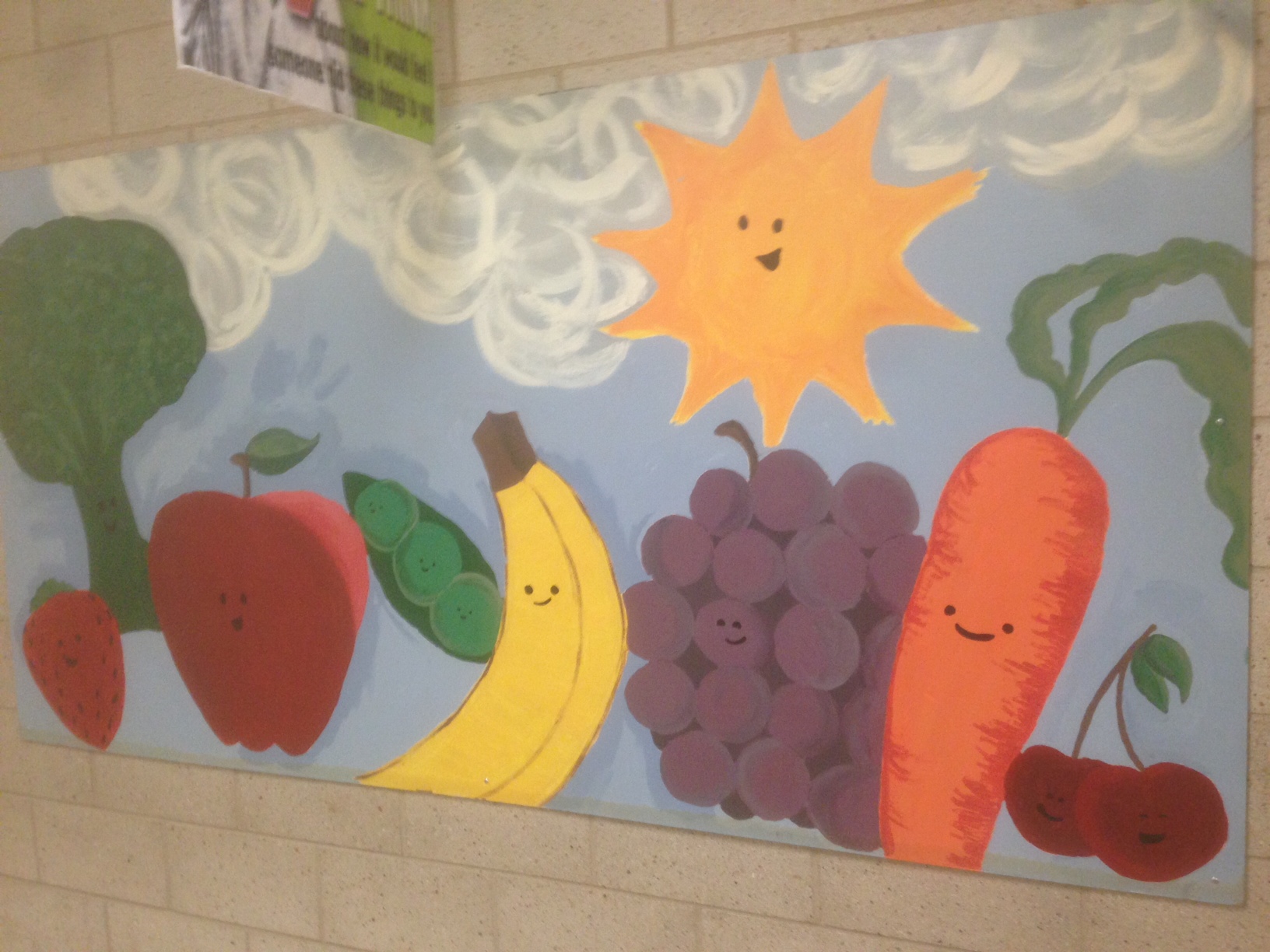Author Archive: Rise & Shine Illinois
School breakfast: the societal benefit
New report shows Illinois ranks 42nd
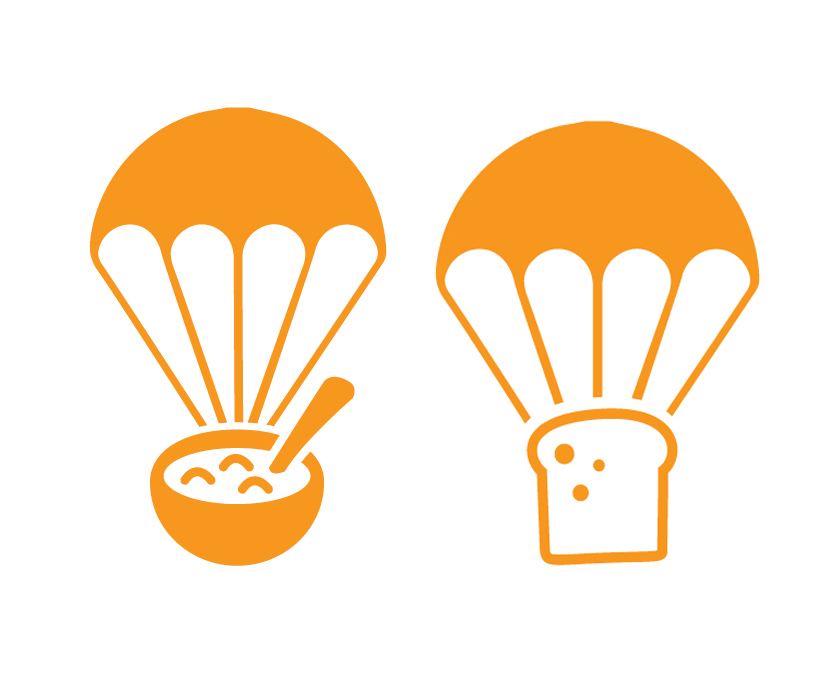
By Bob Dolgan
Campaign Manager
The Illinois State Board of Education Annual Report states that 2,054,556 students were enrolled in Illinois public schools in 2014-2015. In our view, every one of those students deserves an opportunity for a better future. The playing field, though, is uneven for many children, whether due to their own family’s challenges or due to schools’ administrative and funding barriers. As a child advocacy campaign, we can’t control every variable. But we can work to access every resource available to low-income children. It’s our responsibility to give our children and our neighbors’ children a fair chance at success.
A nutritious meal at the start of the school day means that a child is more likely to be properly nourished and able to focus, absorb the lessons being presented and retain the knowledge needed to excel. It’s not an overstatement to say that serving school breakfast can be the first step to a brighter future long-term. The impacts of hunger on brain development in formative years are well documented. And some research connects school breakfast to higher scores on achievement tests. Children who miss meals regularly, especially breakfast, are more likely to be held back a grade, receive special education services and mental health counseling. If the core functional benefit of breakfast is to sate hunger pangs among already at-risk children, the higher purpose is dignity and respect: a quality meal is something that everyone deserves, three times every day. What message do we send by ignoring a program that was enacted by Senators and Representatives and endorsed by Presidents, for the very purpose of aiding low-income children?
The arguments against school breakfast are many, and often soporific. We’ve seen firsthand how skeptical attitudes toward school breakfast change with positive impacts on attendance, tardiness and school wellness. As one teacher told us, “Our day actually gets started quicker than it used to, and calmer.” The Rise and Shine Illinois campaign exists to make setting up a breakfast program easy: we can develop solutions for any school and have the resources to provide schools grant funding for breakfast infrastructure. There are few reasons not to serve breakfast at school.
Today we release breakfast data showing that Illinois ranks 42nd in the nation in serving school breakfast. While average daily participation has increased slightly, the balkanized structure of our 859 school districts makes direct, local advocacy for breakfast district-by-district expensive and time-consuming. Therefore, this spring we will introduce legislation in Springfield that requires schools to serve fully federally funded breakfasts. We will follow up until every eligible child receives a meal at the start of the school day. Providing breakfast is a small step among many needed to enhance our education system, but by valuing every child and nurturing every child individually we have a chance to make progress. And that’s a benefit for all of society.
View the 2015 Rise and Shine Illinois Breakfast Report
View 2014-2015 breakfast data for the top 100 school districts in Illinois
Press release: School Breakfast Program reaching more children in Illinois, yet opportunities remain 2.16.16
Additional after-school meals information sessions announced
CACFP At-Risk After-School Meals Information Sessions – Fall 2015
No Kid Hungry Illinois and the Illinois State Board of Education hosted a series of regional information sessions on the Child and Adult Care Food Program’s At-Risk After-School Meals Program this past summer. Due to high demand, four additional sessions have been added for the fall. The sessions are geared toward potential new sponsors and sites of the After-School Meals Program.
If your after-school program . . .
- Is located in the attendance area of a school with 50% or more free and reduced price eligible children
- Serves snacks or meals out of your own pocket
- Participates in the National School Lunch Program After-School Snacks Program
- Does not serve food at all
. . . Then you should come learn how you can serve nutritious meals for FREE to all children through the USDA’s Child and Adult Care Food Program At-Risk After-School Meals Program, which provides reimbursements for snacks and meals served in eligible low income after-school programs.
Topics to be covered include eligibility, application and administration requirements, partnership resources, best practices and grant opportunities.
Session Dates and Locations
- October 13: Greater Chicago Food Depository, Chicago
- October 21: Illinois Central College, Peoria
- October 29: The Pavilion of the City of Marion, Marion
- November 5: Champaign Public Library, Champaign
*Please note that this information session will be part of an all-day Summer and After-School Meals summit. All sessions are free to attend and lunch and refreshments will be provided. Attendees may register for any or all sessions.
Full Day Agenda
- 9:30am – 1:00pm: Summer Meals Program Topics – for Summer Food Service Program sponsors only
- 1:00pm – 2:15pm: Lunch and Partner Resources Presentations – for both Summer and After-School
- 2:15pm – 3:00pm: Grant Writing Workshop – All the tips and tricks we know!
- 3:00pm – 4:00pm: After-School Meals Info Session for potential new sponsors and sites
CLICK HERE TO REGISTER
All public and charter schools, non-profit community or faith based organizations, recreational or health centers, units of state, local or municipal government, libraries, non-residential child care centers and other eligible institutions are welcome.
If you have any questions, please contact Malaney Varaljay at mvaraljay@gcfd.org or 773.843.6706.
How to end summer hunger in Illinois
By Bob Dolgan
Campaign Manager
In the past four weeks I’ve been to Washington, the St. Louis area, Springfield, and of course, Chicago, helping spread the word about summer meals and learning about solutions that will ensure more children receive food. It’s easy for those of us who mostly sit at desks in climate-controlled offices to conceive of ideas for ending summer hunger, but the reality is that implementation is a generational challenge that requires dramatic policy change and a broad array of stakeholders. There is no universal solution for summer hunger: every region, every state and every community faces unique barriers.
The challenges during summer are clear: Only 15 percent of low-income children in Illinois receive summer meals. A total of more than 640,000 children in the state are food insecure, meaning they face uncertain or limited access to food. In addition to enacting a new Child Nutrition Reauthorization, I believe there are three opportunities that would ensure children are fed: extensive education of the public, a re-shaping of the summer meals experience and an injection of private funding.
- Child Nutrition Reauthorization: First and foremost, we need a strong Child Nutrition Reauthorization to replace the law that expires Sept. 30. CNR will set funding for all child nutrition programs, including school breakfast and lunch, and summer meals, for the next five years. Proposals in the Senate’s recent draft of a bill would enable the delivery of mobile meals, aiding children in urban and rural areas of Illinois. In urban areas, crossing busy streets in high-crime areas is a safety hazard; in rural areas, existing sites are far apart (some counties do not have any sites at all). Summer participation would increase almost immediately if the new bill is passed.
- Educating the public is important, both for the families we serve in summer and the potential supporters of the program. Many families simply don’t know where meals are available. And if they do know, it can be daunting to go to an unfamiliar site in a time of great need. The majority of sites are open to any family, including public schools that offer a welcoming environment, and in Chicago, “Lunch Stop” food carts outside of CPS sites. (Note: Our No Kid Hungry Illinois program is a proud funder of the Lunch Stop program.) Anyone in the general populace can help connect families to summer meals. If you don’t know someone in need, someone you know does. Our social media platforms and website, www.summermealsillinois.org, make it easy to share information.
- There are more than 1,700 summer meal sites in Illinois, and every one is unique. They range from Camp Ondessonk, a sleep-away camp in southern Illinois’ Shawnee National Forest, to Altgeld 13136, a building in Chicago’s Altgeld Gardens’ public housing complex. Due to resource constraints, many sites cannot provide much more than a meal when children arrive at their doors. Recreational and educational activities, though, bring sites alive with the sounds of children at play while addressing the academic “summer slide” that takes place children are not in school. At outdoor sites surrounded by asphalt, even one picnic table transforms the experience. Making summer sites about more than food adds dignity and respect for the people we serve.
- More dollars are needed at every level of the Summer Foodservice Program, starting with funding for the meals. Most summer providers do not have the equipment or resources to offer made-from-scratch meals to children. The quality of the meals makes a significant difference, particularly for teens who already are fickle eaters. Additional dollars to acquire tasty, quality ingredients would help. Many programs, entirely operated by volunteers, have been hit hard by state budget reductions and have struggled to keep their doors open. And if new provisions are available in the next CNR, we will need transportation to reach distant rural areas and the infrastructure to serve urban and suburban areas where there are gaps.
Summer is only one component of the solution to child hunger. We face challenges during the breakfast and after-school time periods, too. But as summer winds down, we have opportunities to think about what more we can do in time for next year. And inch closer to a day when no child goes hungry.
Learn more: follow @RiseAndShineIL, @SummerMealsIL, @EndHungerIL
Register for CACFP after-school meals 2015 info sessions
New Sponsor Workshops – Summer 2015
The USDA provides reimbursements for snacks and meals served in eligible low-income after-school programs through the Child and Adult Care Food Program (CACFP) At-Risk After-School Meals Program.
In collaboration with the Illinois State Board of Education, No Kid Hungry Illinois will be hosting a series of information sessions for interested new CACFP At-Risk After-School Meals sponsors and sites.
All schools, churches, community organizations, rec centers, libraries, park districts, health centers, and other non-profit or for-profit entities welcome! Topics to be covered:
- The need: learn the scope of after-school meals in Illinois, identify meal gaps and target areas
- The solution: general CACFP At-Risk program information – assessment tools, financial calculators
- How to: become a sponsor or site!
- Illinois specific eligibility, application instructions, administration, reimbursements
- Transitioning from Summer Meals Program and NSLP after-school snacks to offering meals year-round through CACFP
- Best practices: strategies for successful implementation, outreach and partnerships
- Grant Opportunities: No Kid Hungry after-school meals expansion and pilot grants
Register today!
- Tuesday, July 21; 1pm – 3pm – Four Points Sheraton Hotel, 319 Fountains Parkway, Fairview Heights, IL 62208
- Thursday, August 6; 1pm – 3pm – Peoria Public Library, 107 NE Monroe St, Peoria, IL 61602
- Wednesday, August 19; 1pm – 3pm – Hilton Hotel, 3003 Corporate West Drive, Lisle, IL 60532
Contact Malaney Varaljay at mvaraljay@gcfd.org or 773.843.6706 to RSVP.
Community Eligibility Provision (CEP)
An innovative approach to offering universal free school breakfast and lunch
What is it?
The Community Eligibility Provision allows schools and local educational agencies (LEAs) in high-poverty areas to offer free breakfast and lunch to all students without having to go through the standard household application process to determine meal program eligibility. Any school district can use this option if at least one of its schools has 40 percent or more “Identified Students”, meaning, students who are certified for free meals using other forms of direct certification data such as qualifying for Supplemental Nutrition Assistance Progarm (SNAP), Medicaid, Head Start, etc. By removing the burden of having to collect household applications to determine eligibility for the few students that do not qualify for free or reduced-price meals, CEP significantly lessens the administrative work of having to collect and verify school meal applications and allows schools to focus on feeding children.
Introduced by the The Healthy, Hunger-Free Kids Act of 2010, this option is now available to all schools, nationwide – the deadline to opt in for the 2015-2016 school year is August 31, 2015.
What are the benefits?
- Reduced administrative burden – removes paperwork for both parents and school staff, lowering administrative costs, eliminating the need to track unpaid meal charges and allowing staff to focus on improving education and meal service operations.
- Increases participation and factilitates implementation of alternative breakfast models – maximizes access to free nutritious meals to students, reducing stigma and making it easier for schools to implement Breakfast in the Classroom and Grab N Go.
- Improves efficiency and financial viability of school nutrition programs – CEP schools traditionally show significant increases in breakfast and lunch participation, resulting in higher revenue through reimbursements, which districts can use to improve meal program quality.
How it works
The percentage of Identified Students multiplied by 1.6 = the percentage of meals reimbursed at the “free” rate. The rest of the meals are reimbursed at the paid rate. Therefore, the higher the poverty level (Identified Student Percentage), the higher the reimbursement rate.
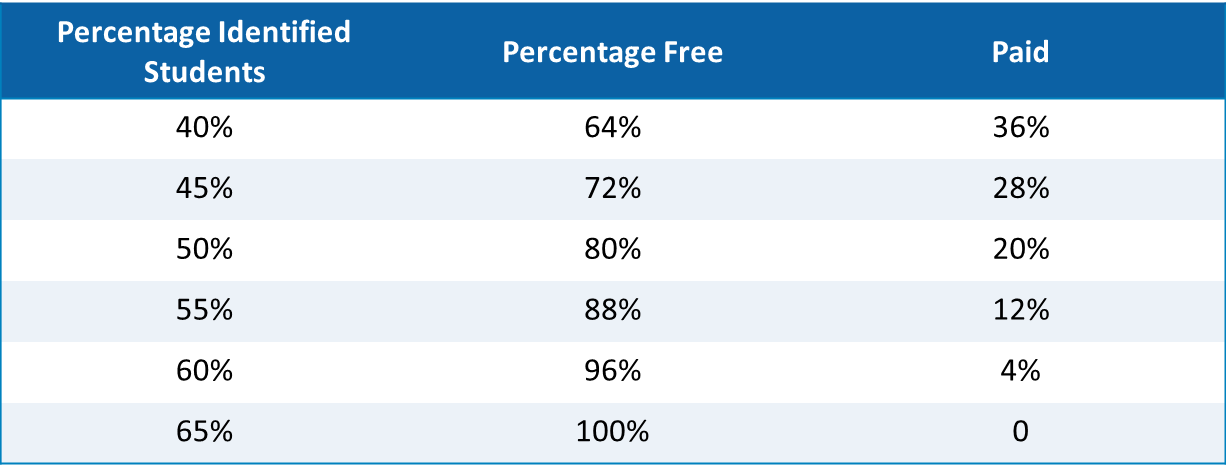
Schools can determine their eligibility status by visiting the Center on Budget and Policy Priority’s CEP eligibility database and can also use tools like the No Kid Hungry School Calculator to help determine the financial viability of becoming CEP.
Illinois was one of the first states to pilot CEP in the 2011-2012 school year and since then, has grown from less than 250 to over 1,000 schools participating. According to the Food and Research Action Center, breakfast and lunch participation in the first three pilot states, Illinois, Michigan and Kentucky, increased by 25% (29,000 meals) and 13% (23,000 meals) respectively, in CEP schools within the first two years. Such increases in participation underscore the impact of community eligibility and its ability to improve low-income children’s access to healthy meals at school, particularly through the School Breakfast Program, which has been underutilized. Administrators, child nutrition staff, and parents in participating schools, who experience the benefits of community eligibility first hand, have enthusiastically embraced the option¹.
However, compared to the rest of the nation only 55% of Illinois’ eligible school districts and 29% of eligible schools participate¹. This means, we can do better.
What can you do?
- Apply to become CEP for the 2015 – 2016 school year by August 31, 2015 with the Illinois State Board of Education.
- Utilize the tools, resources and information fact sheets on the Share Our Strength Center for Best Practices Community Eligibility Provision webpage.
- Take action and connect with a Rise & Shine breakfast coordinator, who can help:
- Determine the best breakfast plan for your school or district
- Provide technical assistance for implementing CEP and alternative breakfast models
- Assist with applying for Rise & Shine Illinois breakfast grants
After-school Grants Awarded!

The children are all smiles while eating an after-school meal at the Fleetwood Jourdain Community Center in Evanston. The City of Evanston sponsors the Center’s At-Risk After-School Meals program and is a recent recipient of a No Kid Hungry Illinois after-school meals expansion grant.
In partnership with Rise & Shine Illinois, the Illinois No Kid Hungry campaign awarded its first round of expansion grants for the Child and Adult Care Food Program (CACFP) At-Risk After-school Meals Program. The purpose of the grants is to help sponsors maximize their ability to serve full supper meals and expand participation in the program. $10,000 was awarded to six different sponsoring organizations throughout the state:
- Northern Illinois Food Bank, Geneva
- Catholic Charities of Chicago, Chicago
- City of Evanston, Evanston
- Casa Central, Chicago
- Church of Peace, Rock Island
- Urbana Neighborhood Connections Center, Urbana
Grants are still available! Applications are accepted on a rolling basis with two remaining deadlines. The next application deadline is August 15. For full grant details and to apply, click here.
For Chicago school, breakfast is a source of pride
“Our waste log never gets filled”
Too often we hear what can’t be done to serve breakfast at school. But that’s not the case at Beidler School on Chicago’s West Side. At Beidler, breakfast is part of the school day. In fact, breakfast, lunch and supper are part of the day. The school’s doors open to students at 7:30 a.m. and close at 7 p.m.
“We educate socially, emotionally and academically,” said Principal Charles Anderson. “If they’re hungry, it’s hard to do any of those things.”

Charles Anderson
The meaning of school, and community, takes on another dimension at Beidler, a public elementary in the East Garfield Park neighborhood. School at Beidler is about much more than educating children from pre-K to eighth grade. It’s about supporting a community and providing a “safe haven,” in the words of Mr. Anderson. The school keeps its doors open longer because of the flexibility needed by parents. A significant percentage of students are homeless, and many parents are working multiple jobs to make ends meet.
East Garfield Park faces a food insecurity rate of 38.5 percent, nearly three times the statewide rate. Mondays and Fridays are the busiest days in the Beidler School kitchen. Mondays because children arrive at school having eaten sparingly over the weekend. Fridays because children ask for seconds to tide them through until Monday.
“Our waste log never gets filled,” said Mr. Anderson.
For too many low-income families, breakfast becomes one more variable in their lives. The Rise and Shine Illinois campaign is seeking to address food insecurity by expanding school breakfast statewide. Experts agree that breakfast correlates with better attendance, less tardiness and improved academics. Common sense tells us that a hungry child can’t concentrate at school and is at risk of falling behind.
On a recent morning with Mr. Anderson, children approach for a hug, a smile or a few friendly words, the atmosphere becomes familial and perhaps warmer than many schools. “This is my son,” Mr. Anderson said kidding one child who stays in a homeless shelter. Mr. Anderson takes time to greet every parent, teacher and student, seemingly knowing everyone in East Garfield Park by name. The school is a source of pride for the community.
When told that some schools in Illinois, many in fact, don’t participate in school breakfast, Mr. Anderson expressed surprise. It never occurred to him not to serve breakfast.
“They’re missing out on a great way to start the day,” he said “We always say a good breakfast will do everything.”
The next Rise and Shine Illinois breakfast grant deadline is Monday, June 15. Contact us at riseandshineillinois@gcfd.org or
773-247-3663 to learn how to bring breakfast to your school.
Grab N Go Breakfast increases participation by over 120% in Beardstown
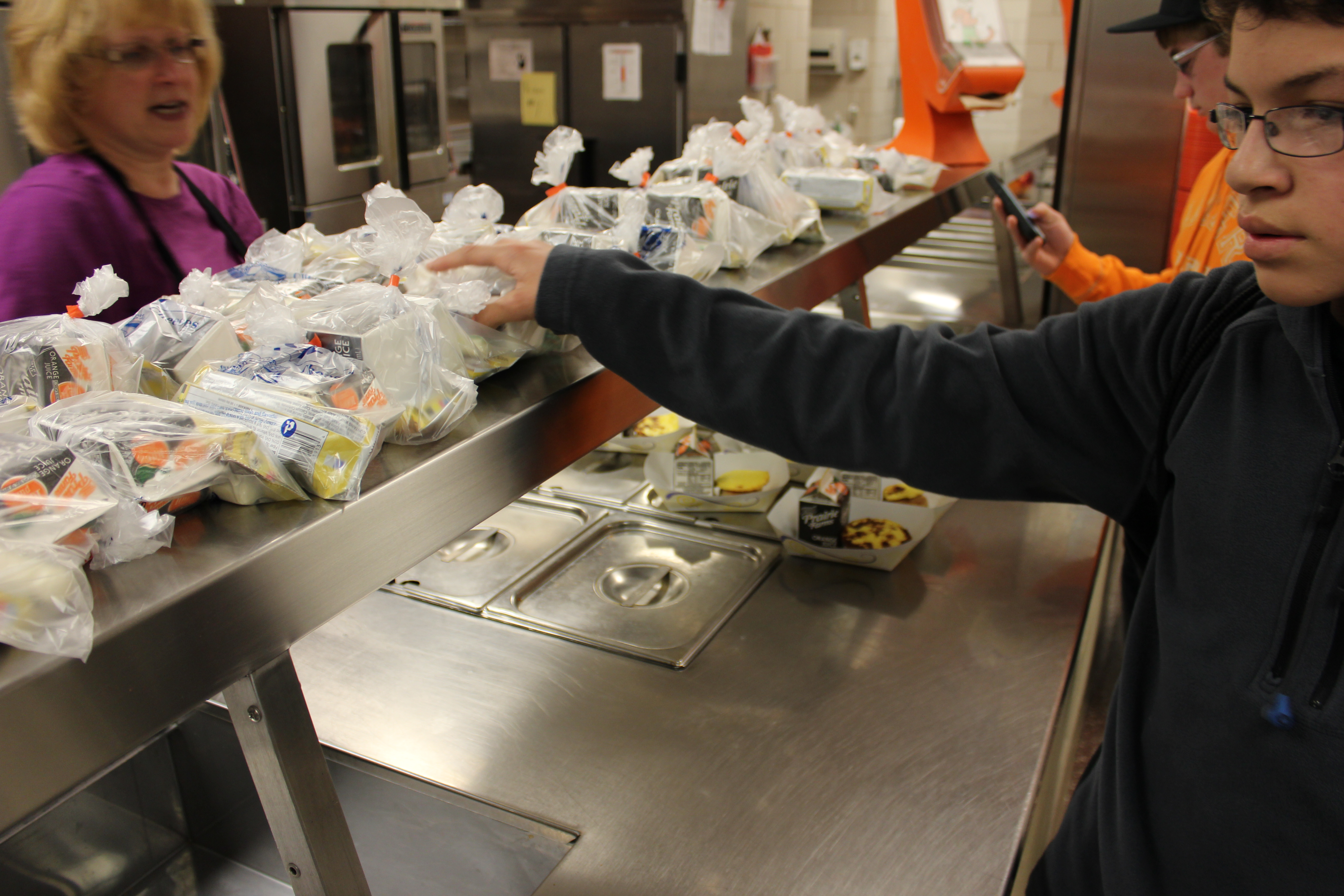
Operating as a well-oiled machine – students grab their breakfast on the way into school each morning and then head off to class.
Nourishing students from the inside out
For many students at Beardstown Junior/High School, the breakfast they receive through the National School Breakfast Program may be one of the only two nutritious meals they receive in a day. According to Principal Scott Riddle, for most of these kids, “If we don’t serve breakfast, they don’t get breakfast.” With over 73% of the school’s student population eligible for free or reduced-priced meals, the need is high and therefore “the goal,” says Riddle, “is to get food into the hands of the kids.”
With the help of a Rise and Shine Illinois grant, Beardstown was able to implement a Grab N Go service model for the 2014-2015 school year in order to make breakfast more accessible to all students and increase participation in the breakfast program. The children simply pick up a packaged hot or cold meal in the cafeteria or hallway as they enter school and eat together before class starts.

Principal Scott Riddle stands in front of an “inspirational” art installation created by the students at Beardstown Junior/High.
To start the Grab N Go program, the Junior/High School needed two Point of Service (POS) terminals, which they were able to purchase with funds from the Rise and Shine Illinois grant. An electronic pad collects student fingerprints as they pick up their meal and it automatically records and tracks the number of meals served in a reporting database. By reducing the amount of time students have to wait in line and the amount of paperwork for administrative staff, the new system makes serving breakfast a more efficient process and ultimately helps to feed more kids meals.
Since implementing the program, Riddle has seen two major improvements – a spike in attendance because kids are coming to school on time in order to get breakfast, and increased productivity in the classroom. “Teachers say you can see kids who are distracted in the classroom because they’re hungry and sleepy. With breakfast, they perform better, they’re more attentive.”
On average, about 520 of the 840 students in the Junior and High School are eating Grab N Go breakfast, a 122% increase over last year. In a county that has a food insecurity rate of over 23%, these meals serve a significant need. Nourishing kids from the inside out, the program not only ensures that the students are receiving a healthy meal but it provides them the opportunity to share and participate in the communal act of eating with one another. As Riddle points out, “Breakfast is about making sure your neighbor has something to eat. It’s teaching a community value.”
After-School Meals Grant Opportunity – Deadline may 15
Rise & Shine Illinois announces After-School Meals grant opportunity through No Kid Hungry Illinois
CACFP At-Risk After-School Meals Program Expansion Grant
Application Deadline: MAY 15, 2015
In partnership with Rise & Shine Illinois, this grant opportunity for up to $2,500 each is funded through Share Our Strength and the Illinois No Kid Hungry Campaign to help At-Risk After-School Meal (aka “Supper”) sponsors expand access to and participation in after-school and extended day meal programs that receive reimbursement through the USDA’s Child and Adult Care Food Program (CACFP). The priority is to help sponsors maximize their ability to provide students in eligible after-school programs (http://www.isbe.state.il.us/nutrition/pdf/at_risk_fs.pdf) with a full supper meal.
Eligibility
The supper program must be:
- Located in an eligible site or area
- Served in conjunction with an eligible after-school enrichment program
Within the scope of the purpose above, the following programs are top priorities for support:
- Starting new CACFP supper programs in conjunction with eligible after-school enrichment programs.
- Sponsors currently providing after-school snacks supported by either CACFP or the National School Lunch Program (NSLP) who wish to expand their program to provide a full meal in place of or in addition to a snack.
- Sponsors currently providing a CACFP supported supper, looking to expand or enhance their program to help them reach more children.
All applying organizations must be either 501(c)(3) nonprofits currently in good standing, schools/school systems approved to participate in CACFP or NSLP, local government agencies able to accept grants, or churches/tax-exempt religious organizations not required to apply for official 501(c)(3) status.
You must have already started the CACFP application process with your state agency at the time you submit your grant application. We will accept grant applications from organizations that have started the process and/or are awaiting approval from your state agency; however grants will only be awarded to organizations that are approved as program sponsors.
Eligible Uses of Funds
These grants are intended to help with costs associated with starting or growing a supper program, including, but not limited to:
- Staffing
- Equipment
- Program costs (per USDA guidelines, programs that wish to provide a full supper must provide some kind of enrichment programming)
- Outreach to increase enrollment
- Support to offset registration or other enrollment fees for low-income families
- Transportation
Average Grant Award: $2,500
Reporting Requirements
If funded, you will be required to complete a report on the following:
- Financial report on use of funds
- Monthly participation numbers
- Interim and final narrative report on the successes and challenges of your program over the course of the program
Organizations that do not submit a report will be ineligible to receive future grants from Share Our Strength.
Grant applications will be evaluated based on:
- Adherence to Eligibility and Requirements guidelines
- Program sustainability beyond the grant funding period
- Growth potential for CACFP afterschool meals and snack program participation.
All applicants must submit a complete application; incomplete applications will not be considered.
Application Due Date
Applications will be accepted on a rolling basis through November 15, 2015 with three deadlines: May 15th, August 15th and November 15th.
CLICK HERE TO APPLY. You will need to create a user profile. Use the access key: ILCACFP2015 when prompted (all caps).





